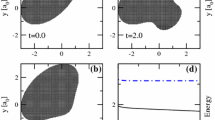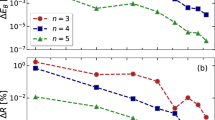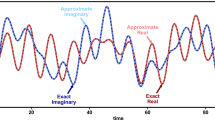Abstract
The quantum Hamilton–Jacobi equation (QHJE) is formally equivalent to the time-dependent Schrödinger equation, and the solutions to the QHJE can be easily interpreted in terms of trajectories providing a link between classical and quantum mechanics. The trajectory-based approaches to quantum molecular dynamics are, generally, appealing because they circumvent exponential scaling associated with exact quantum methods with the system size, and because, unlike classical molecular dynamics, such methods incorporate dominant quantum effects due to delocalization of wavefunctions describing the nuclei. We explore the utility of the QHJE framework for calculations of the time-correlation functions (TCFs) involving quantum evolution defined by the Boltzmann density operator and by the Hamiltonian time-evolution operator. The implementation is based on solutions to the imaginary-time counterpart to the QHJE, which yield approximations to the ground state wavefunction. The resulting nodeless wavefunction is used to generate a basis in coordinate space, which is efficient for evaluation of the low-lying excited states and of the quantum TCFs, including the Kubo-transformed TCFs, at low temperature. The QHJE/basis approach is illustrated on several model systems in and out of thermal equilibrium, i.e., the \({\rm H}_2\) dimer and bound anharmonic potentials. If a system exhibits large amplitude motion, e.g., in case of the nonequilibrium dynamics, then the real-time trajectory propagation provides an alternative to the basis representation, as demonstrated on a model describing the inversion mode of the ammonia molecule and ion.







Similar content being viewed by others
References
Berne BJ, Harp GD (1970) On the calculation of time correlation functions. Wiley, Hoboken, pp 63–227
Hele TJH (2017) Thermal quantum time-correlation functions from classical-like dynamics. Mol Phys 115:1435–1462
Craig IR, Manolopoulos DE (2005) Chemical reaction rates from ring polymer molecular dynamics. J Chem Phys 122:084106
Cao J, Voth GA (1993) A new perspective on quantum time correlation functions. J Chem Phys 99:10070–10073
Miller WH (2001) The semiclassical initial value representation: a potentially practical way for adding quantum effects to classical molecular dynamics simulations. J Phys Chem A 105:2942–2955
Thoss M, Wang HB, Miller WH (2001) Generalized forward–backward initial value representation for the calculation of correlation functions in complex systems. J Chem Phys 114:9220–9235
Liu J (2015) Recent advances in the linearized semiclassical initial value representation/classical wigner model for the thermal correlation function. Int J Quantum Chem 115(11):657–670
Makri N (2004) Forward–backward quantum dynamics for time correlation functions. J Phys Chem A 108(5):806–812
Topaler M, Makri N (1994) Quantum rates for a double well coupled to a dissipative bath: accurate path integral results and comparison with approximate theories. J Chem Phys 101(9):7500–7519
Madelung E (1927) Quantum theory in hydrodynamic form. Z Phys 40:322–326
de Broglie L (1926) Interference and corpuscular light. Nature 118:441–442
Bohm D (1952) A suggested interpretation of the quantum theory in terms of hidden variables, I and II. Phys Rev 85:166–193
Garashchuk S, Rassolov VA (2004) Modified quantum trajectory dynamics using a mixed wavefunction representation. J Chem Phys 121(18):8711–8715
Garashchuk S, Rassolov VA, Schatz GC (2005) Semiclassical nonadiabatic dynamics using a mixed wave-function representation. J Chem Phys 123:174108
Feynman RP, Hibbs AR (1965) Quantum mechanics and path integrals. McGraw-Hill, New York
Zhao Y, Miller WH (2002) Semiclassical initial value representation for the Boltzmann operator in thermal rate constants. J Chem Phys 117:9605–9610
Kosloff R, Tal-Ezer H (1986) A direct relaxation method for calculating eiegenfunctions and eigenvalues of the Schrodinger equation on a grid. Chem Phys Lett 127:223–230
Meyer HD, Gatti F, Worth GA (2009) Multidimensional quantum dynamics: MCTDH theory and applications, chapter computing eigenstates by relaxation and improved relaxation. Wiley, Hoboken
Zhang DH, Light JC, Lee SY (1999) Transition state wavepacket study of H diffusion on Cu(100) surface. J Chem Phys 111:5741
Rassolov VA, Garashchuk S, Schatz GC (2006) Quantum trajectory dynamics in arbitrary coordinates. J Phys Chem A 110:5530–5536
Zhao Y, Makri N (2003) Bohmian versus semiclassical description of interference phenomena. J Chem Phys 119:60–67
Babyuk D, Wyatt RE (2004) Coping with the node problem in quantum hydrodynamics: the covering function method. J Chem Phys 121:9230–9238
Kendrick BK (2010) An iterative finite difference method for solving the quantum hydrodynamic equations of motion. J Mol Struct Theochem 943:158–167
Sanz AS, Borondo F, Miret-Artes S (2002) Particle diffraction studied using quantum trajectories. J Phys 14:6109–6145
Sanz AS, Borondo F, Miret-Artés S (2004) Quantum trajectories in atom-surface scattering with single adsorbates: the role of quantum vortices. J Chem Phys 120(18):8794–8806
Garashchuk S, Rassolov VA (2004) Energy conserving approximations to the quantum potential: dynamics with linearized quantum force. J Chem Phys 120:1181–1190
Press WH, Flannery BP, Teukolsky SA, Vetterling WT (1992) Numerical recipes: the art of scientific computing, 2nd edn. Cambridge University Press, Cambridge
Garashchuk S, Rassolov VA (2003) Quantum dynamics with Bohmian trajectories: energy conserving approximation to the quantum potential. Chem Phys Lett 376:358–363
Coalson RD, Karplus M (1990) Multidimensional variational Gaussian wave packet dynamics with application to photodissociation spectroscopy. J Chem Phys 93:3919–3930
Garashchuk S, Rassolov VA (2008) Stable long-time semiclassical description of zero-point energy in high-dimensional molecular systems. J Chem Phys 129:024109
Garashchuk S, Dixit V, Gu B, Mazzuca J (2013) The Schrodinger equation with friction from the quantum trajectory perspective. J Chem Phys 138(5):054107
Rassolov VA, Garashchuk S (2004) Bohmian dynamics on subspaces using linearized quantum force. J. Chem. Phys. 120:6815–6825
Gu B, Hinde RJ, Rassolov VA, Garashchuk S (2015) Estimation of the ground state energy of an atomic solid by employing quantum trajectory dynamics with friction. J Chem Theory Comput 11(7):2891–2899
Liu J, Makri N (2005) Bohm’s formulation in imaginary time: estimation of energy eigenvalues. Mol Phys 103:1083–1090
Garashchuk S (2010) Quantum trajectory dynamics in imaginary time with the momentum-dependent quantum potential. J Chem Phys 132:014112
Garashchuk S (2012) Calculation of the zero-point energy from imaginary-time quantum trajectory dynamics in Cartesian coordinates. Theor Chem Acc 131:1083
Ramirez R, Lopez-Ciudad T, Padma Kumar P, Marx D (2004) Quantum corrections to classical time-correlation functions: hydrogen bonding and an harmonic floppy modes. J Chem Phys 121(9):3973–3983
Gu B, Garashchuk S (2015) Determination of the collective modes from the quantum-mechanical time-correlation functions. Theor Chem Acc 134(11):129
Liu J, Miller WH (2006) Using the thermal gaussian approximation for the Boltzmann operator in semiclassical initial value time correlation functions. J Chem Phys 125(22):224104
Liu J, Miller WH, Fanourgakis GS, Xantheas SS, Imoto S, Saito S (2011) Insights in quantum dynamical effects in the infrared spectroscopy of liquid water from a semiclassical study with an ab initio-based flexible and polarizable force field. J Chem Phys 135(24):244503
Welsch R, Song K, Shi Q, Althorpe SC, Miller TF III (2016) Non-equilibrium dynamics from RPMD and CMD. J Chem Phys 145:204118
Duque JG, Chen H, Swan AK, Shreve AP, Kilina S, Tretiak S, Xiaomin T, Zheng M, Doorn SK (2011) Violation of the condon approximation in semiconducting carbon nanotubes. ACS Nano 5(6):5233–5241
Roy P-N, Voth GA (1999) On the Feynman path centroid density for Bose–Einstein and Fermi–Dirac statistics. J Chem Phys 110(8):3647–3652
Garashchuk S, Vazhappilly T (2010) Multidimensional quantum trajectory dynamics in imaginary time with approximate quantum potential. J Phys Chem C 114:20595–20602
Garashchuk S, Mazzuca J, Vazhappilly T (2011) Efficient quantum trajectory representation of wavefunctions evolving in imaginary time. J Chem Phys 135(3):034104. https://doi.org/10.1063/1.3610165
Schmidt M, Fernández JM, Faruk N, Nooijen M, Le Roy RJ, Morilla JH, Tejeda G, Montero S, Roy P-N (2015) Raman vibrational shifts of small clusters of hydrogen isotopologues. J Phys Chem A 119(50):12551–12561
Förster J, Plésiat E, Magaña Á, Saenz A (2016) Imaging of the umbrella motion and tunneling in ammonia molecules by strong-field ionization. Phys Rev A 94:043405
Baiardi A, Bloino J, Barone V (2017) Simulation of vibronic spectra of flexible systems: hybrid DVR-harmonic approaches. J Chem Theory Comput 13:2804–2822
Aquino N, Campoy G, Yee-Madeira H (1998) The inversion potential for NH3 using a DFT approach. Chem Phys Lett 296:111–116
Frster J, Saenz A (2013) Theoretical study of the inversion motion of the ammonia cation with subfemtosecond resolution for high-harmonic spectroscopy. ChemPhysChem 14:1438–1444
Shao Y, Gan Z, Epifanovsky E, Gilbert ATB, Wormit M, Kussmann J, Lange AW, Behn A, Deng J, Feng X, Ghosh D, Goldey M, Horn PR, Jacobson LD, Kaliman I, Khaliullin RZ, Kus T, Landau A, Liu J, Proynov EI, Rhee YM, Richard R M, Rohrdanz M A, Steele RP, Sundstrom EJ, Woodcock HL III, Zimmerman PM, Zuev D, Albrecht B, Alguire E, Austin B, Beran GJO, Bernard YA, Berquist E, Brandhorst K, Bravaya KB, Brown ST, Casanova D, Chang C-M, Chen Y, Chien SH, Closser KD, Crittenden DL, Diedenhofen M, DiStasio RA, Hainam D Jr, Dutoi AD, Edgar RG, Fatehi S, Fusti-Molnar L, Ghysels A, Golubeva-Zadorozhnaya A, Gomes J, Hanson-Heine MWD, Harbach PHP, Hauser AW, Hohenstein EG, Holden ZC, Jagau T-C, Ji H, Kaduk B, Khistyaev K, Kim J, Kim J, King RA, Klunzinger P, Kosenkov D, Kowalczyk T, Krauter CM, Lao KU, Laurent AD, Lawler KV, Levchenko SV, Lin CY, Liu F, Livshits E, Lochan RC, Luenser A, Manohar P, Samuel FM, Mao S-P, Mardirossian N, Marenich AV, Maurer SA, Mayhall NJ, Neuscamman E, Oana CM, Olivares-Amaya R, O’Neill DP, Parkhill JA, Perrine TM, Peverati R, Prociuk A, Rehn DR, Rosta E, Russ NJ, Sharada SM, Sharma S, Small DW, Sodt A, Stein T, Stueck D, Su Y-C, Thom AJW, Tsuchimochi T, Vanovschi V, Vogt L, Vydrov O, Wang T, Watson MA, Wenzel J, White A, Williams CF, Yang J, Yeganeh S, Yost SR, You Z-Q, Zhang IY, Zhang X, Zhao Y, Brooks BR, Chan GKL, Chipman DM, Cramer CJ, Goddard WA III, Gordon MS, Hehre WJ, Klamt A, Schaefer HF III, Schmidt MW, Sherrill CD, Truhlar DG, Warshel A, Xu X, Aspuru-Guzik A, Baer R, Bell AT, Besley NA, Chai J-D, Dreuw A, Dunietz BD, Furlani TR, Gwaltney SR, Hsu C-P, Jung Y, Kong J, Lambrecht DS, Liang WZ, Ochsenfeld C, Rassolov VA, Slipchenko LV, Subotnik JE, Voorhis TV, Herbert JM, Krylov AI, Gill P MW, Head-Gordon M (2015) Advances in molecular quantum chemistry containedin the Q-Chem 4 program package. Mol Phys 113:184–215
Kosloff R (1988) Time-dependent quantum-mechanical methods for molecular dynamics. J Phys Chem 92:2087–2100
Feit MD, Fleck JA Jr, Steiger A (1982) Solution of the Schrödinger equation by a spectral method. J Comput Phys 47:412–433
Wigner EP (1932) On the quantum correction for thermodynamic equilibrium. Phys Rev 40:749–759
Heller EJ (1976) Classical limit of the Liouville equation. J Chem Phys 65:1289
Brown RC, Heller EJ (1981) Classical trajectory approach to photodissociation: the Wigner method. J Chem Phys 75:186–188
Wehrle M, Oberli S, Vanicek J (2015) On-the-fly ab initio semiclassical dynamics of floppy molecules: absorption and photoelectron spectra of ammonia. J Phys Chem A 119:5685–5690
Heller EJ (1975) Time-dependent approach to semiclassical dynamics. J Chem Phys 62:1544
Acknowledgements
This material is based upon work supported by the National Science Foundation under Grant No. CHE-1565985 and by an ASPIRE grant from the Office of the Vice President for Research at the University of South Carolina. The authors thank P.-N. Roy for providing the \(\hbox {H}_2\) dimer potential and for bringing this model to our attention. SG is grateful to Tom Miller and Ralph Welsch for insightful discussions and for sharing their results pertaining to the nonequilibrium time-correlation function formalism and RPMD. She also acknowledges the California Institute of Technology and the Miller group for hosting her as a short-term visitor, while on sabbatical leave from the University of South Carolina.
Author information
Authors and Affiliations
Corresponding author
Appendix: Variational approximation to the quantum potential
Appendix: Variational approximation to the quantum potential
An analytically form of the approximate quantum potential \({\widetilde{U}}\) is essential for efficiency and accuracy of the quantum force computation. One way to achieve such \({\tilde{u}}\) is to represent the nonclassical component, r(x, t), of the QM momentum operator, defined by Eq. (7), as a superposition of basis functions in coordinate space. Approximation to this single object within a basis \(\vec {f}(x)\),
gives analytically approximate quantum potential,
and analytically quantum force \(F^{q}=-\nabla {\widetilde{U}}\). A detailed derivation for multidimensional systems is given in Ref. [28].
Vector \(\vec {c}\) contains the time-dependent basis expansion coefficients, which are found by minimizing the average deviation between r(x, t) and \({\tilde{r}}(x,t)\)
Equation (A3) is obtained from integration by parts assuming \(\rho =0\) at the limits of integration; \(I_0\) denotes the term which does not depend on \(\vec {c}\). By changing the integration variable to \(x_t\), using Eq. (16), and replacing the integration with summation over discrete trajectories, one obtains
The fact that neither \(\rho (x,t)\) nor its derivatives appear in Eq. (A4) is of central importance for efficient implementation. The algorithm scales linearly with respect to the number of trajectories, since a single summation over the trajectories gives all the necessary matrix and vector elements.
Minimization of I with respect to the expansion coefficients yields a system of linear equations,
Here \({\varvec{S}}\) is the time-dependent matrix of the basis function overlaps; \(\vec {b}\) is the vector of averages of the spatial derivatives of the basis functions,
The optimal coefficients are the elements of the vector,
As shown in Ref. [26], \({\widetilde{U}}\) evaluated at the optimal values of \(\vec {c}\), \(\nabla _c I=0\), conserves the total energy of a wavefunction for time-independent classical potentials,
The energy is conserved because \({\widetilde{U}}\) is proportional to \(I-I_0\). Thus, minimization of I is equivalent to the variational determination of \({\widetilde{U}}\).
The smallest physically meaningful basis \(\vec {f}(x)\) consists of just two functions \(\vec {f}=(1,x)\), and the approximation can be written in a particularly transparent form,
The wavefunction is normalized to 1, and the nonclassical momentum is approximated with a linear function centered at the average position of the wavepacket and inversely proportional to its variance, \(\sigma =\langle x^2\rangle -\langle x\rangle ^2\). This functional form of \({\tilde{r}}\) generates a quadratic \({\widetilde{U}}\) and, consequently, a linear quantum force. Hence, the approximation is termed the linearized quantum force (LQF). Note that \(F^q\) is inversely proportional to \(\sigma ^2\); therefore, \(F^{q}\) quickly vanishes for delocalized wavepackets.
From the physical point of view, the linear nonclassical momentum exactly corresponds to a Gaussian wavepacket evolving in time in a locally quadratic potential. For general potentials, it can describe the dominant quantum effects in semiclassical systems, such as wavepacket bifurcation, wavepacket spread in energy, and moderate tunneling. The zero-point energy effects are often described often for a few vibrational periods, depending on the anharmonicity of a system.
Rights and permissions
About this article
Cite this article
Ekanayake, N.T., Garashchuk, S. Evaluation of the quantum time-correlation functions employing the Hamilton–Jacobi dynamics framework. Theor Chem Acc 138, 8 (2019). https://doi.org/10.1007/s00214-018-2398-6
Received:
Accepted:
Published:
DOI: https://doi.org/10.1007/s00214-018-2398-6




